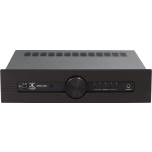Pre Amplifiers - Synthesis
As an alternative to a single box integrated amplifier that combines pre and power in one, using a separate hi-fi pre amplifier and power amplifier amp is considered the ideal amplifier set-up to most hi-fi enthusiasts and audiophiles. These option typically offers better performance than an integrated amplifier by virtue of the fact they benefit from dedicated designs, separate power supplies and other features. A pre amp connects to your source (streamer, DAC, CD player, turntable, etc) offering volume and source selection with the power amplifier powering the speakers.
As such. pre amps do not include speaker outputs but rather feature RCA or XLR outputs to connect to a separate power amplifier, which then connects to your bookshelf or floorstanding speakers. Some pre amps include a dedicated headphone amplifier section and/or DAC to connect your digital sources directly in addition to RCA or balanced XLR inputs. Some purist pre amplifiers focus solely on pre amp duties, in which case you can add a dedicated headphone amplifier or DAC to your system. For further advice on pre/power amplifiers or anything else for your system, please call or e-mail us.
Synthesis have over 30 years experience making valve audio equipment. The current range includes a selection of integrated valve amplifiers, valve pre/power amplifiers and other models. Whatever your needs they have a model that will take your system to the next level, combining warm sound with modern Italian design.
The synthesis ethos is no compromise sound, as well as built quality. For example they make their own output transformers using only the best possible materials. The iron core is high grade as is the copper wire. Nowadays copper wire is produced that has a much higher purity and lower resistance than in the past. As a result modern transformers outperform those that were once prevalent. Moreover, other components are much better performing. Metal film resistors are more accurate in value and lower in noise. Additionally, polypropylene capacitors will not short or go leaky.
Hi gain circuits need careful design as does the power supply. Synthesis use oversized transformers that are mounted well away from the signal circuits. They are also very well regulated. For example the heaters are fed from a DC supply to prevent any hum or noise being injected into the valves. The signal paths on the PCB’s are also kept as short as possible. Some of the amplifiers also have balanced inputs and outputs to further reduce noise pickup. Finally, usability is good with some units having a remote control. Take you audio to another level with Synthesis.
Some Synthesis amps are pure analogue devices while other have built in DACs. There are also amplifiers with built in phono preamps for vinyl lovers. A step us is a preamp / mono block amplifier combination and synthesis have this option available. Power outputs range from 25W to 80W. There are also stand alone phono preamps as well as DAC’s and CD players with valve output stages.
The reason for separation of the pre amp and power amplifier is a concept that applies to virtually every product across hi-fi. Greater performance will virtually always be had by having everything which can be separate housed in a separate unit. A standalone phono stage will typically offer better performance than one within an integrated amplifier, and the same logic applies to DACs, headphone amplifiers and most other hi-fi products. One key reason for this phenomenon is the separation of power supplies. Power supplies are typically described as “noisy”, they vibrate and resonate and can cause unwanted interference which can have undesired effect on the audio signal and ultimately the sound your hi-fi produces and your enjoyment of your favourite records and music collection. By housing a pre amp and a power amplifier in separate boxes, their respective power supplies are also separated and isolated from one another, making it much easier to preserve signal quality and prevent any interference.
Manufacturers go to great lengths to isolate the potentially noisy power supplies and transformers required to power the pre amp from the delicate circuitry. These techniques, as well as varying features, connectivity and build quality, is what separates one amplifier from another, and is the reason why some cost a large amount more than others. One technique involves suspending the power supply and isolating it from the sensitive components, so that resonance is not passed through the chassis.
A key concept in Pre Amp design is signal integrity. That is to say that the signal the pre amplifier takes from your source (CD player, turntable, tuner etc.) needs to remain untouched and uncoloured by tone controls, resonance or filters, and must be fed to the power amplifier as an untouched signal. Most hi-fi manufacturers and high end pre amp hold to the mantra that attempts to improve signal quality will always have an adverse effect on musicality and the overall sound produced by your hi-fi. High quality pre amp seek to be as simple as possible internally, in order to maintain signal quality and integrity. Most designs seek for the shortest possible signal paths and direct cable routing internally to prevent longer runs of cabling allowing for interference and negative effects of resonance, RF and power supplies.














































































